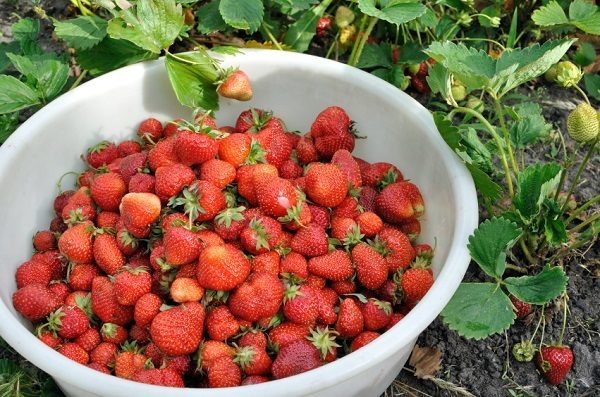
A strawberry patch in the garden or even a few plants in containers can give you plenty of fruit to go straight from the plants to the table.
Growing strawberry plants is not hard at all.
But to get the best yield out of your plants, you need to pay attention to a few things such as choosing the right variety for your area as well as your needs, planting at the right time, and providing the right growing conditions.
Selecting strawberry varieties suitable for your area:
Some strawberry varieties adapt to a wide range of growing conditions, including temperature.
Chandler, Douglas, Sequoia and Camarosa, Sunset, Seascape and Tristar are examples. However, there might be specific varieties that are ideal for your particular zone.
If you want to produce a lot of fruit for making jams and jellies in addition to eating fresh berries, it is best to choose a high-yielding variety developed for your USDA zone.
Selecting varieties to meet your specific needs:
The strawberry cultivars you choose should meet your needs.
There are three different types of strawberries to consider before you decide on which variety, or which combinations would work for you.
June-bearing strawberries:
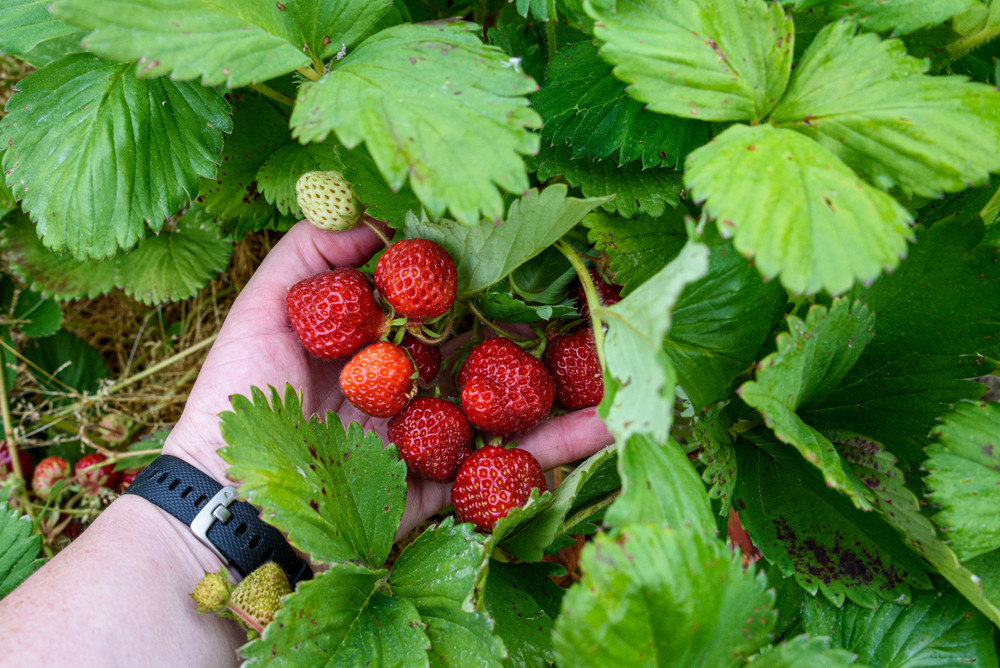
Strawberry cultivars that give a single large crop, usually in June as the name implies, belong to this group.
The flush of flowers in spring is followed by a large number of fruit that ripen all at once so that the harvest will be over in just 2-3 weeks.
You get large fruit with good flavor.
If you intend to make jams and jellies or freeze a large amount of fruit, June-bearing types are for you.
Some of the best June-bearing varieties are:
- Northwest – Big, attractive berries suitable for drier areas
- Allstar – Late season strawberry resistant to Verticillium wilt and Red stele, producing sweet fruit with mild flavor.
- Benton – Flavorful berries of medium size
- Hood – Large berries ideal for making jams and jellies
- Totem– Very flavorful, medium-sized berries
Ever-bearing strawberries:
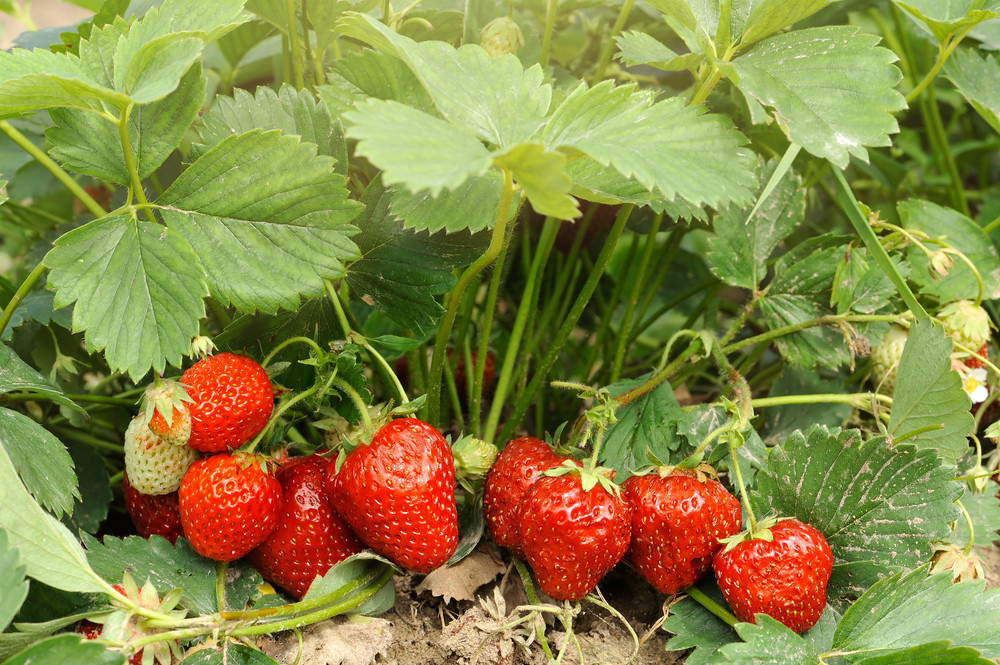
These cultivars usually give a large crop in June, but it may not be as substantial as that of June-bearers.
However, they compensate by producing another flush of flowers and fruit towards the end of summer.
If your main intention is to have plenty of strawberries to eat, rather than store or process them, find ever bearers suitable to your zone. You can choose the ones that have sweetness and flavor that appeal to you.
You can, of course, make jams and jellies from these, but in smaller doses.
Some popular ever-bearing varieties are:
- Chandler – Large and juicy strawberries preferring dry climate
- Ogallala– Early producer, great for home gardeners impatient for strawberries
- Ozark Beauty – Plants adaptable to a wide range, producing large, mildly sweet fruit.
- Sequoia – Heavy yield of great-tasting berries, but they are medium-sized.
- Tristar – Heavy producer of large, flavorful berries
Day-neutral strawberries:
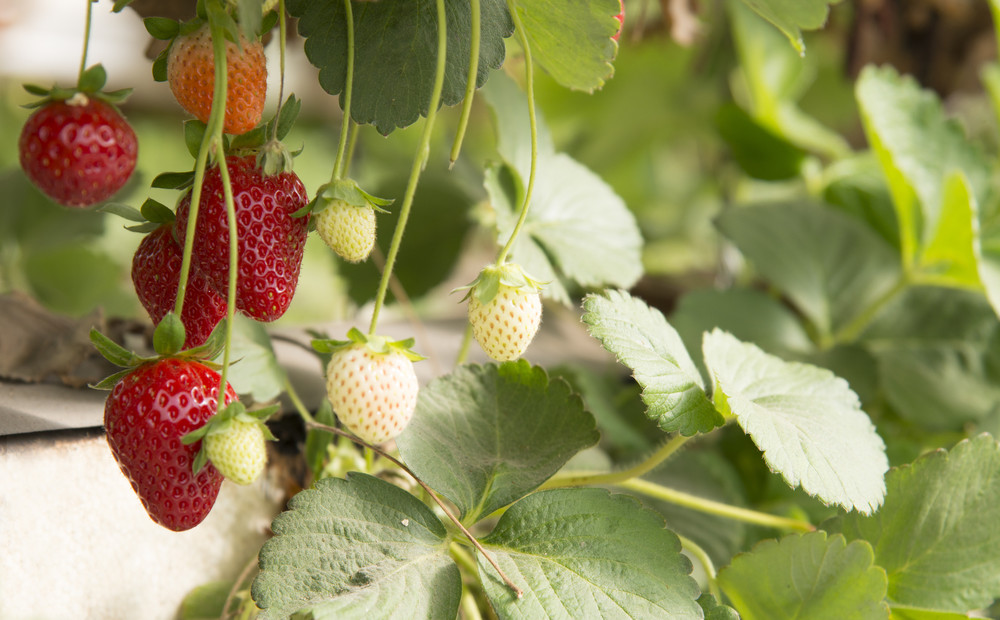
The flowering of strawberries is influenced by the length of day. While short days in fall instigate flower bud formation in June-bearers, long days initiate flower production in ever-bearers.
Day neutral type of strawberries are unaffected by the length of days.
They do not give large crops at a time but stagger their yield over a 4-month period from June to September.
Go for this type if you like to pick and eat strawberries straight from the plant.
You will find flowers and fruit at various stages of development on the same plant.
Some Day-neutral strawberries to look for:
- Albion – flavorful, dark red berries, resistant to Verticillium wilt and crown rot
- Seascape – Disease-resistant and heat tolerant plants producing large, shiny, flavorful fruit
- San Andreas – Berries with outstanding shape and flavor, suitable for warm climates
Alpine strawberries:
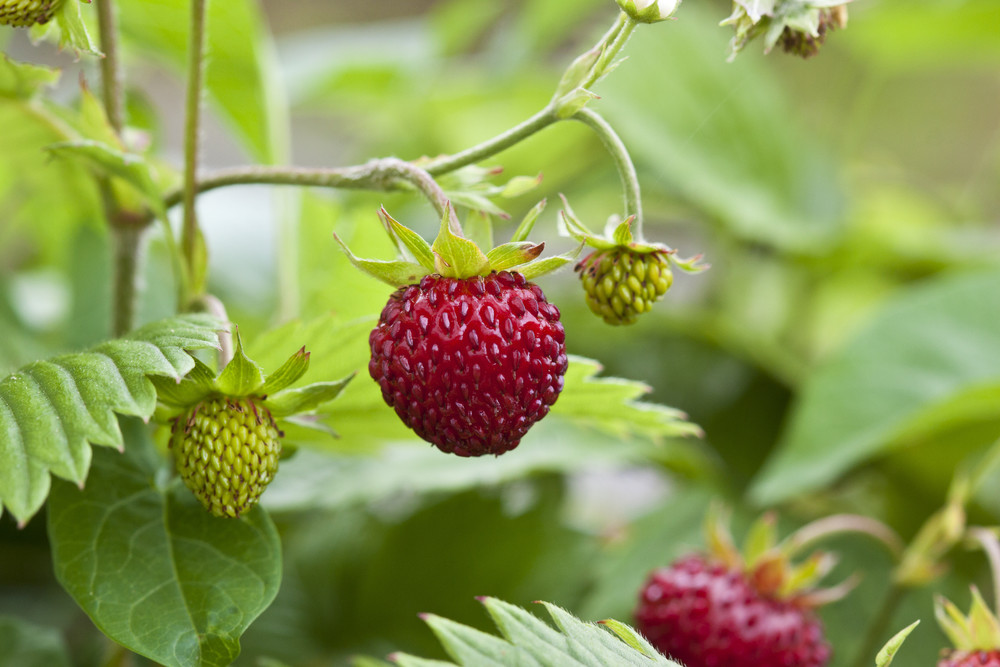
These strawberries are any type of wild strawberries that are ever bearing.
Alpine strawberries in cultivation are improved varieties of wild strawberry called Frugaria vesca.
The garden strawberries are actually a hybrid of different Frugaria species, hence they are known as Frugaria X ananassa.
Alpine strawberries are excellent for growing indoors or on the patio because they do well in partial shade.
They have a long harvest season, practically being pick-and-come-again types. The berries are much smaller than garden strawberries, but some have intense aroma and flavor to make up for it.
Look out for these Alpine strawberry varieties:
- Mignonette- The bright scarlet berries are highly flavorful and scented.
- Alexandria- Larger berries in dark red color
- Pineapple punch – White variety with sweet berries that have a hint of pineapple
Grow strawberries in the ground or in containers:
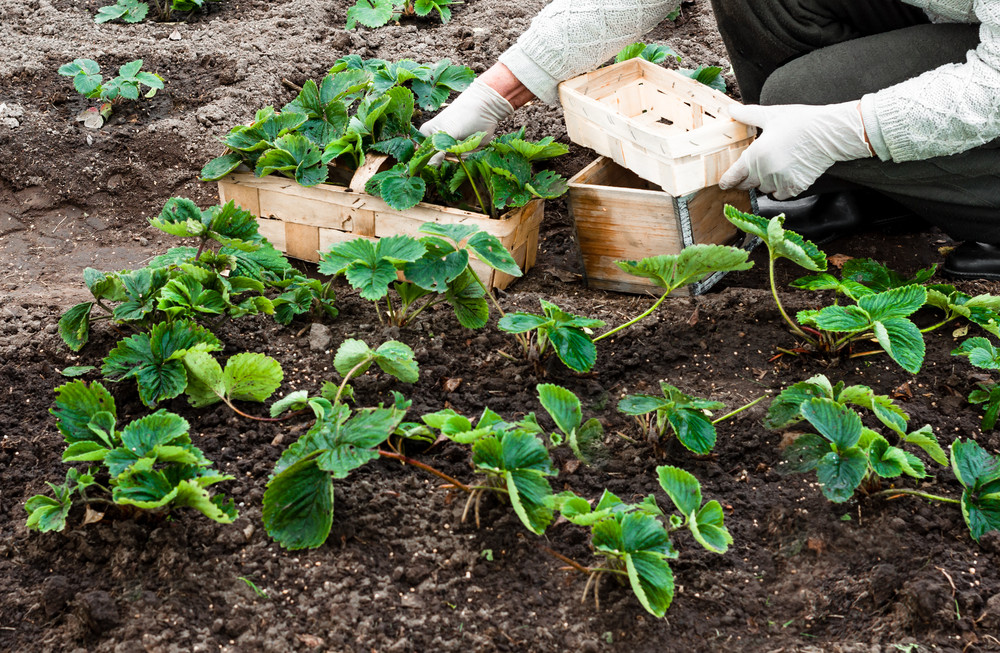
Strawberries are traditionally grown in the ground. That gives the plants plenty of space to spread out their stolons and grow new plantlets.
In fact, left to their devices, they will take over the entire area, proving to be quite invasive.
However, to get a good yield, the strawberry patch should be maintained well, avoiding overcrowding by removing plantlets and weeds that compete with the yielding plants for light and nutrients.
If you have sunny spots in the garden, make a strawberry patch by cultivating the soil and enriching it with lots of organic matter.
You will be richly rewarded for your efforts.
A single plant can give you anything from 1 pound of fruit to 3 pounds, depending on the variety. A strawberry patch with two or three 10ft rows should keep a family of four in strawberries all through the season.
If you don’t have the time and energy to do all the soil cultivation, weeding and pruning required to maintain a strawberry patch, grow them in containers.
It has many advantages.
For one thing, you can control the cultural conditions like light, water, temperature, and feeding. Besides, you may not have to deal with weeds.
The plantlets that hang outside the containers can be easily removed to allow the mother plants to grow and prosper, and provide a good yield.
Harvesting strawberries from container-grown plants is easier too because the ripening fruit usually hangs outside the pots.
It saves you time and money needed to line the strawberry patch with straw to keep the berries from touching the soil and rotting. You can easily check them for optimum color and ripeness and pick them effortlessly.
Containers can be moved to new locations to take maximum advantage of sunlight, the direction of which may vary from season to season.
They can be taken indoors when the weather is hostile; giving them the cool comfort of your home during hot periods and protection from killer frosts.
Outdoors or Indoors?
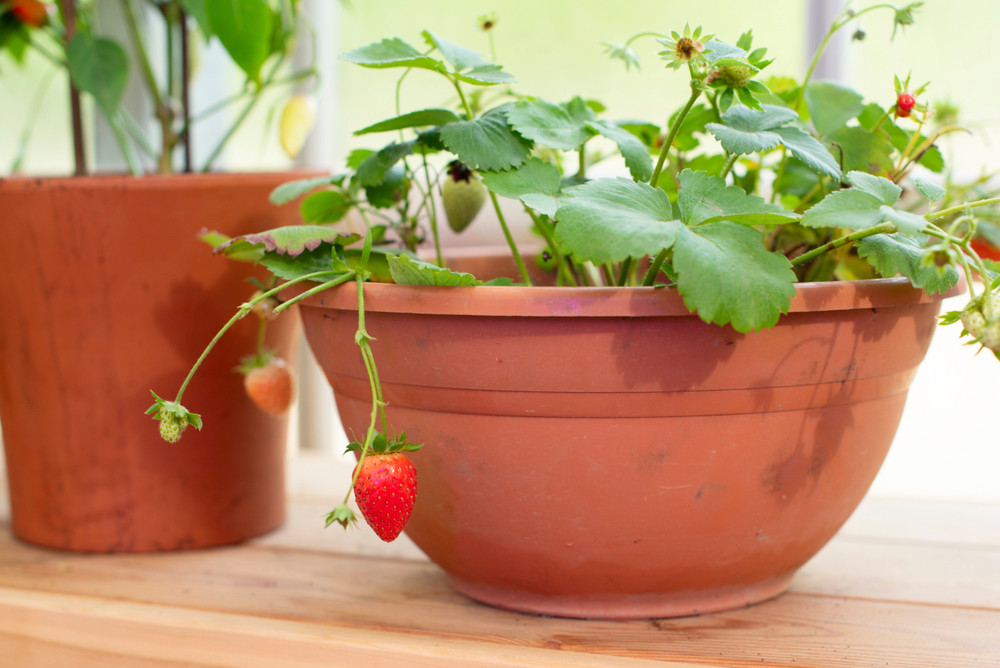
As mentioned before, strawberries love the outdoors, and thrive best in well-cultivated patches or raised beds.
If you don’t have enough outdoor space for that, these high-light plants can be grown indoors in greenhouses or containers kept close to a sunny window.
Indoor cultivation makes sense if you live in a place with hot summers or long, freezing winters without snow cover.
However, unless you can provide plenty of light, the yield may suffer. An exception is Alpine strawberries that do well in partial shade.
Hanging baskets or strawberry pots?
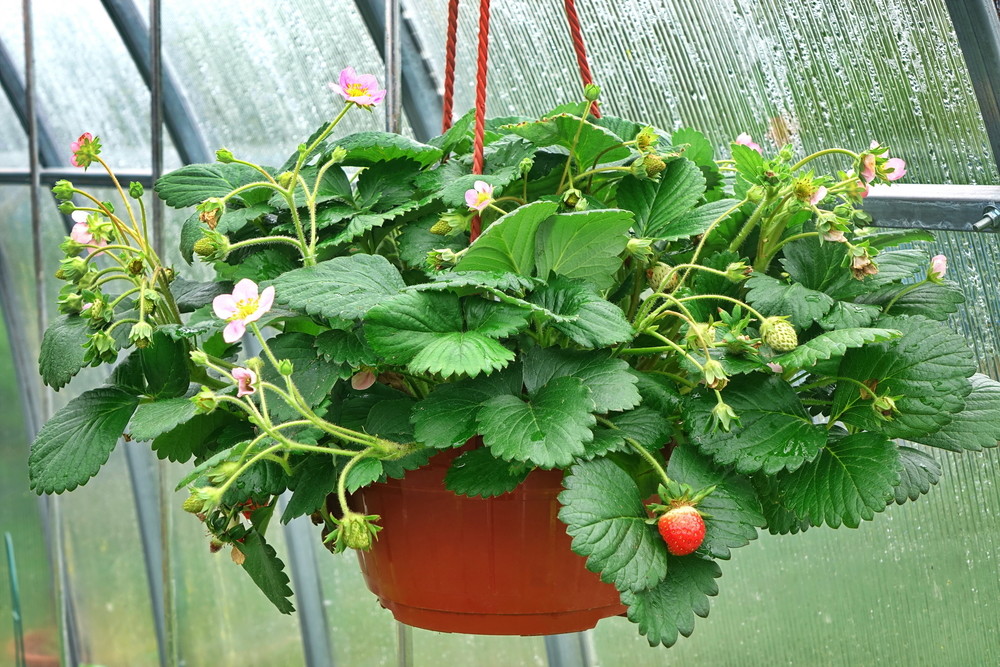
Strawberry pots with holes or pockets all around may be the obvious choice of many container gardeners wanting to grow strawberries, especially those who are growing them for the first time.
The little pockets at the sides are meant to provide a place for the plantlets to take root.
But if you’re going to plant them at the same time as the top of the pot, the plants on the sides would be at a disadvantage.
They wouldn’t get as much sunlight as the plants on the top. It is difficult to ensure equal distribution of water and fertilizers too.
If space is premium, you can settle for a vertical tower of strawberries, but you should keep them in full sun or keep turning the pot to make sure all the plants get sufficient sunlight.
It helps to have a central watering pipe too such as a PVC pipe with holes along its length to cater to all the plants from top to bottom.
Strawberries would be much better off if planted individually in regular pots or in a single row in a long container.
Rain gutters kept on benches or hung up to save space make excellent strawberry containers. In fact, hanging containers are excellent for several varieties because they give plenty of space for the plants to stretch out.
Did you know that even the color of the containers matter?
Dark colored containers can absorb heat from the summer sun and radiate it to the surroundings.
It may create a microclimate that is too warm for the strawberries.
Select light colored ones or use terracotta pots. The latter has minute pores that continually release water vapor, keeping the soil and the surroundings cool.
The hanging baskets or pots should be 12-15 inches deep to allow good root run. Line the baskets with peat or coir to retain moisture.
Add good quality potting soil rich in organic matter to provide sufficient nourishment to the plants.
When to plant strawberries:
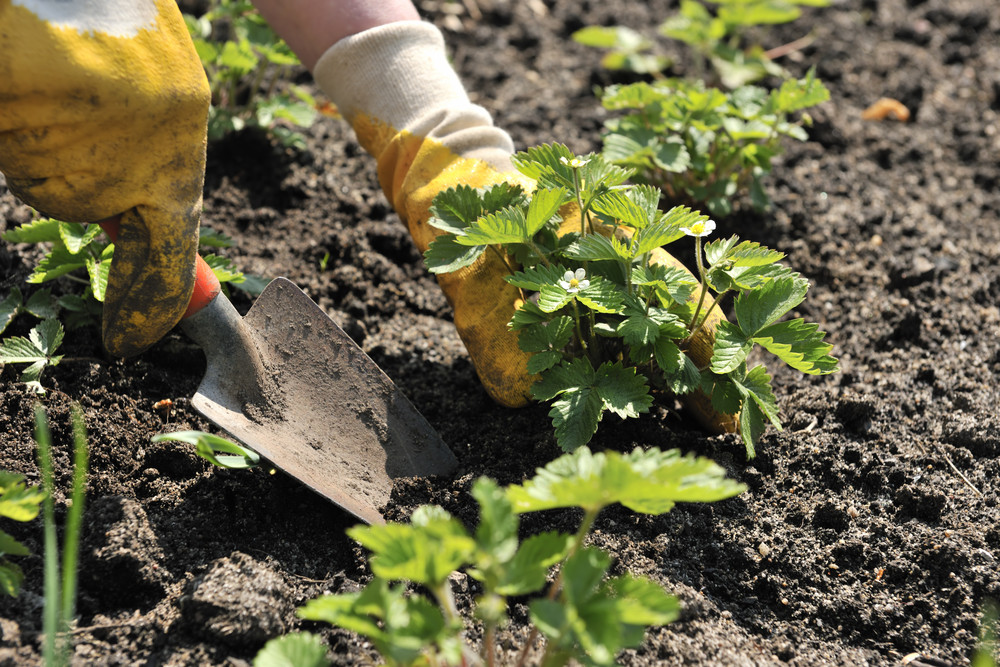
Again, this depends on where you live. Strawberries need time to establish a good root system before they can give good crops.
The more time you can give, the better it is.
That means early spring planting, as soon as the ground thaws, if you’re living in an area with severe winters. USDA zones 6 and below come under this.
March, April, and May are strawberry planting months here but note that June-bearers planted in March-May don’t produce berries until June the following year.
The plants can take advantage of the entire growing season until the ground freezes over again.
They need good winter protection, but they will be up and ready to go the next spring, thanks to their well-developed roots.
Those living in warmer areas, from USDA zone 7-10 can plant their strawberries in fall, to get a crop the following season.
In other words, if you plant in December or January, you can expect a crop within months.
In fact, commercial growers in USDA zones 9 and 10 grow strawberries as annuals.
But home gardeners prefer to grow them in containers and move them to a cooler location or bring them inside for the major part of summer.
Companion planting with strawberries:
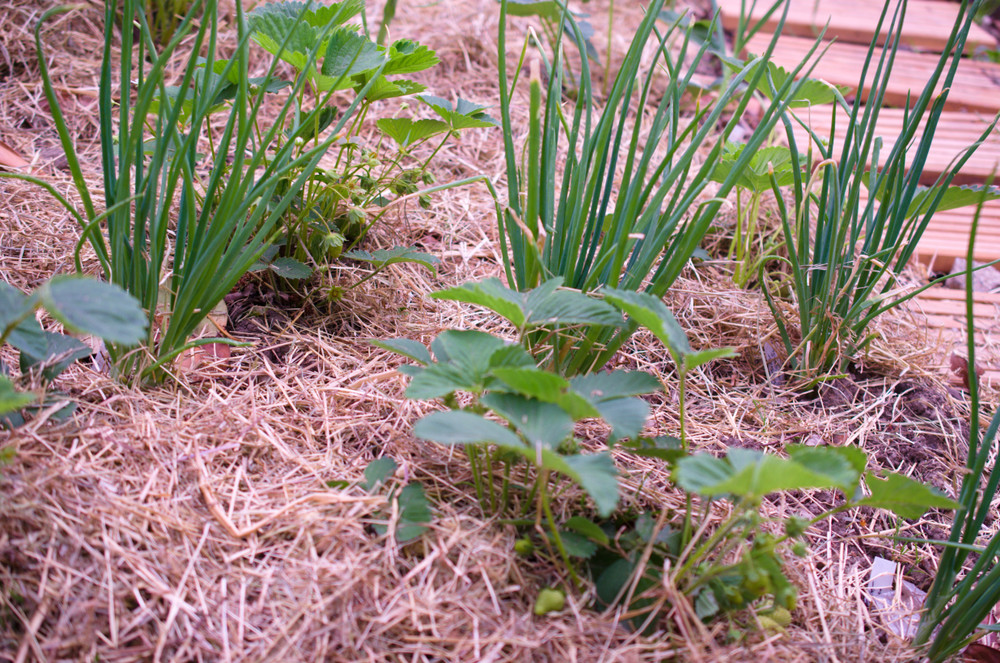
Strawberry plants make plantlets left and right, leaving very little space for other plants to thrive along with them.
However, locating your strawberry patch closer to flowerbeds has some advantages.
Honeybees and other pollinators that visit the flowers may help fertilize the strawberry flowers too, leading to a heavier crop.
Legumes like bush beans and lupin planted with strawberries may benefit the strawberry plants by fixing nitrogen. But they shouldn’t block the sunlight strawberry plants crave for.
Bush beans can also help by repelling beetles that may trouble strawberries.
Caraway may be planted near strawberries to attract certain wasps and flies that feed on strawberry plants.
Borage is considered the best companion plant for strawberry. This herb is beneficial in more ways than one.
When planted in the strawberry patch, borage attracts bees, wasps, and other insects, helping with both pollination and pest control.
Borage is known to improve not only the yield but the flavor of the strawberries.
However, limit it to one borage plant in every 4 ft of your strawberry patch.
How to nurture your strawberry plants:
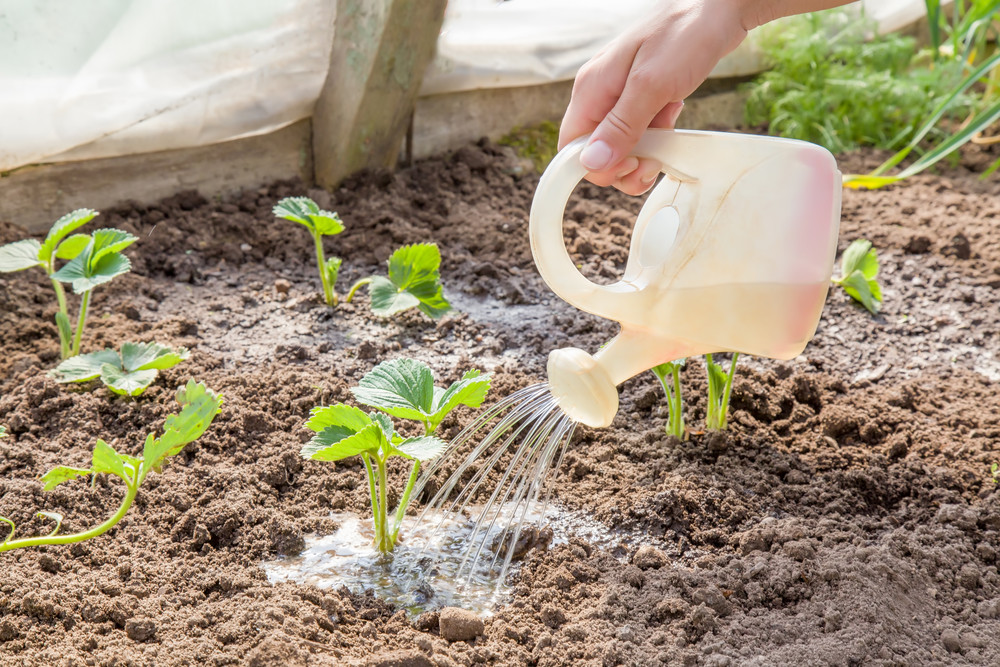
Strawberries enjoy a cool climate and are ideally suited to the temperate zone.
Although several varieties have been developed for warmer areas, they suffer in the intense heat, refusing to produce flowers and fruit.
That is one reason why they are better off indoors near a sunny window than outside in full sun in places with hot summers.
Strawberries love rich, slightly acidic soil. A pH of 5.5 to 6.5 is ideal.
Use plenty of compost and manure while planting, and top dress with organic fertilizers.
Regular watering and feeding with an NPK 10-10-10 ensure healthy growth. High-potassium-Low-nitrogen fertilizers help increase yield.
Pinch off all the flowers that appear on newly planted strawberries until they are 6-8 weeks old.
They should be concentrating on growing a good root system before turning their focus to fruit production. This ensures better yield later on.
Strawberry patches should be lined with straw before the fruit develops.
As the berries get heavier, their stalks arch down, bringing the berries close to the ground. They may rot if they touch the soil, so prevent that by inserting a barrier.
Straw is a good barrier, but plastic mulch is often used in its place.
Both have their own advantages.
Straw is organic, and increases soil fertility as it disintegrates, but plastic can prevent weed problem and preserve moisture.
Poke some holes in the plastic to allow the soil to breathe and rain water to reach the soil.
Protecting your plants:
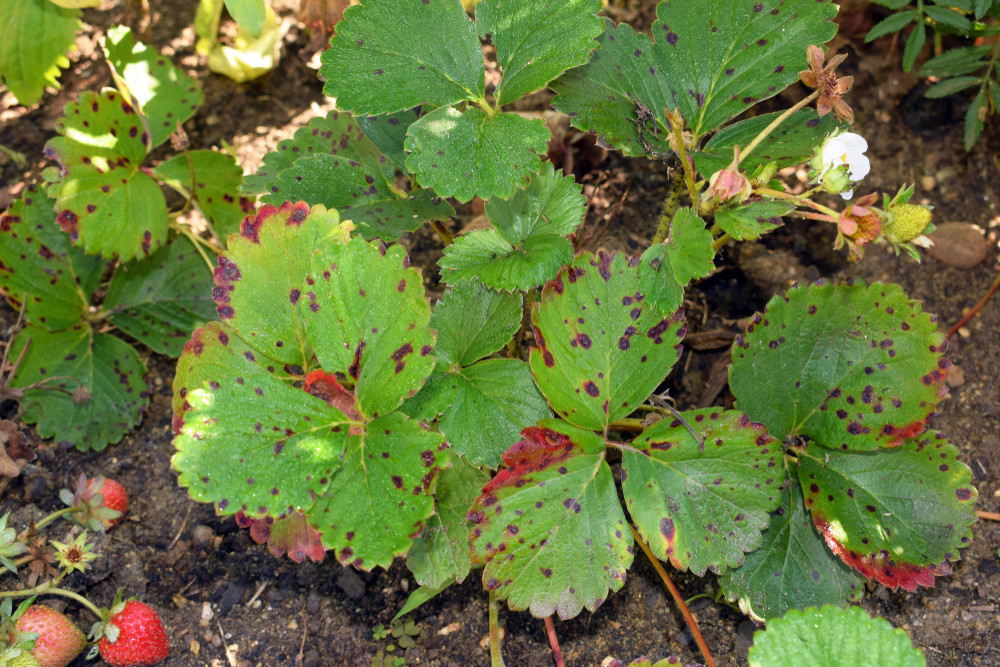
Strawberry plants are not without enemies. A number of diseases and pests attack them, some completely devastating the strawberry patch and others robbing you of the berries.
You should take steps to prevent diseases and pests, but fungicides and pesticides should be avoided as far as possible.
Getting chemical-free strawberries is the main attraction of growing your own plants.
Diseases:
Many types of molds and mildews affect strawberry plants, causing, leaf, bud or fruit rot.
Avoiding crowding and too much moisture in the foliage may prevent many of them.
Verticillium wilt is a devastating disease, so look for Verticillium wilt-resistant varieties and avoid growing other Verticillium-prone plants like tomatoes, potatoes and peppers anywhere near strawberries.
Don’t plant strawberries in beds previously used for growing these veggies either.
Remove diseased plants as soon as possible, and take organic control measures.
Choose a new location for your strawberry patch after 3-4 years.
Slugs and snails:
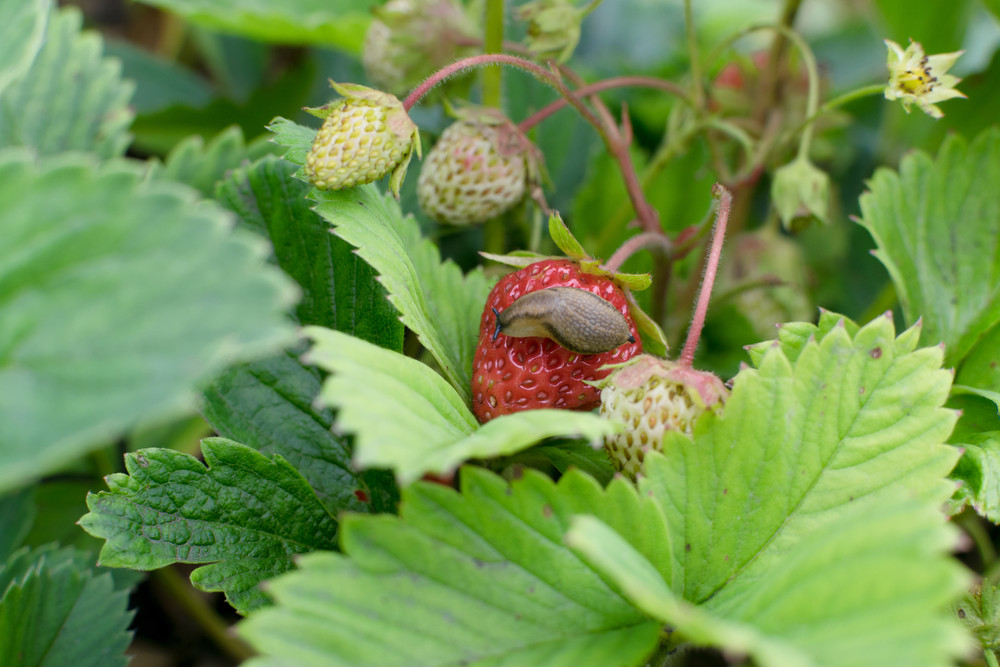
These pesky critters are a big problem with ground-hugging plants. You can use beer traps to lure them away from your strawberry patch.
Other remedies such as sprinkling diatomaceous earth around the plants works too.
Hanging planters have an advantage here.
Birds:
Strawberries are irresistible to birds, and they make short work of your crop in no time unless you control their access.
Plastic or wire netting over strawberry patches or hoops or cloches over containers help save the berries for your table.
Harvesting strawberries:
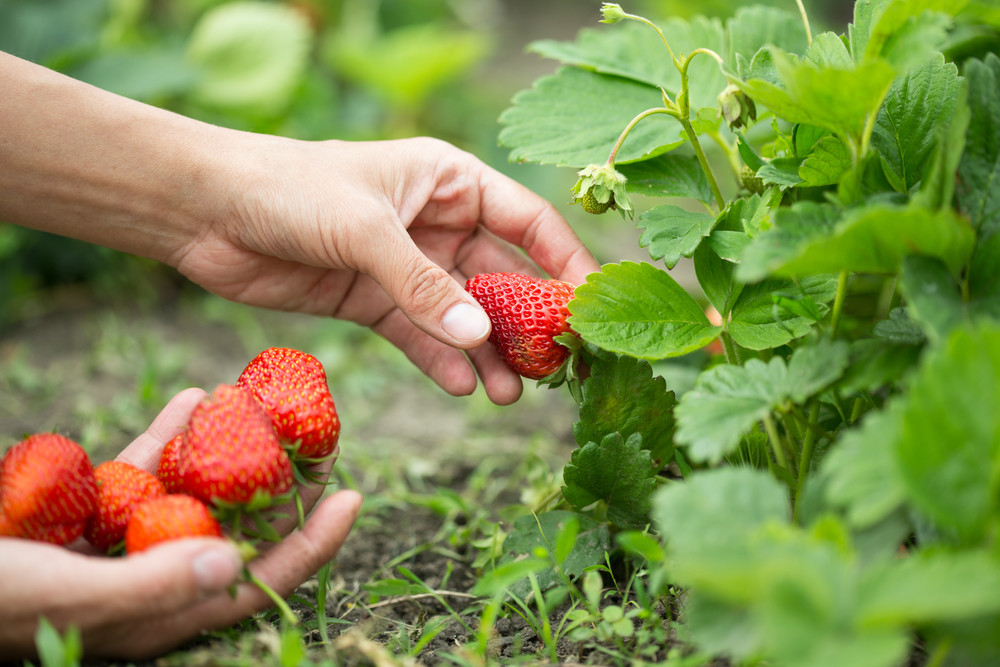
It is such a delight to pick ripe strawberries, but you should go by their taste and flavor rather than their color.
They stop ripening once they are plucked.
For harvesting June-bearers, you have a window of 2-3 weeks, but ever-bearing strawberries may have ripening fruit in between their two major crops.
Pick day-neutral and alpine strawberries as and when they ripen. Frequent picking promotes flowering and ultimately gives you more berries.
The berries should be handpicked without bruising them or pulling on the plant.
They are ideally nipped with your nails or a pair of scissors, leaving an inch of stalk on each fruit.
Eat them fresh or store them unwashed in refrigerator until you are ready to use them.
